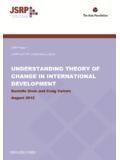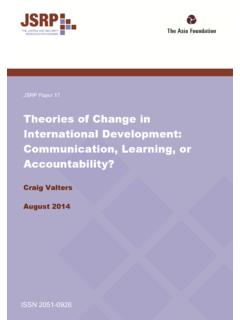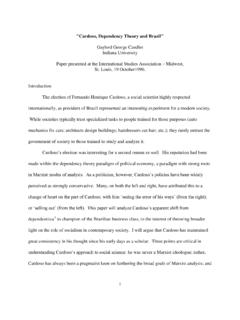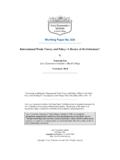Transcription of Chapter 6 THE BIG FIVE CAREER THEORIES - דף הבית
1 Chapter 6 THE BIG five CAREER THEORIESS. Alvin LeungCareer guidance and counselling in the western world, most notably in the United States (USA), has developed a comprehensive system of THEORIES and intervention strategies in its more than 100 years of history. It began in the years of Frank Parson as a trait-factor approach in the early twentieth century (Betz, Fitzgerald, & Hill, 1989; Zunker, 2002), and slowly evolved to become a rather mature discipline today in the twenty-first century with a strong theoretical and empirical base, with the potential to further develop into a more global discipline in the years ahead. Indeed, vocational and CAREER related issues are salient across different cultures and nationalities (Hesketh & Rounds, 1995; Leung, 2004). In an age of economic globalisation, all individuals are affected by an array of work related concerns, some of these concerns are unique to certain cultures, but others are common to many cultural groups.
2 The search for life purposes and meanings, the journey to actualise oneself through various life and work-related roles, and the efforts by nations to deal with problems of employment and unemployment, are examples of universal issues that seem to affect many individuals from diverse cultures. Under the theme of CAREER development , there are experiences, concerns, and issues that we could share, explore, and discussed at a global stage (Richardson, 1993; Lips-Wiersma & McMorland, 2006).The development of CAREER guidance and development into a global discipline requires a set of theoretical frameworks with universal validity and applications, as well as culture-specific models that could be used to explain CAREER development issues and phenomenon at a local level. The focus of this Chapter is on the five THEORIES of CAREER development that have guided CAREER guidance and counselling practice and research in the past few decades in the USA as well as internationally.
3 These five THEORIES are (a) Theory of Work-Adjustment, (b) Holland s Theory of Vocational Personalities in Work Environment, (c) the Self-concept Theory of CAREER development formulated by Super and more recently by Savickas, (d) Gottfredson s Theory of Circumscription and Compromise, and (e) Social Cognitive CAREER Theory. Given that the big- five theoretical models were devel-oped by scholars in the USA, most of the existing reviews and summaries covering The Chinese University of Hong Kong, Hong Kong SAR, Athanasou, R. Van Esbroeck (eds.) International Handbook of CAREER Guidance, 115 Springer Science + Business Media Leungthese frameworks ( , D. Brown & Associates, 2002; S. D. Brown & Lent, 2005; Swanson & Gore, 2000) have drawn from the literature in the USA.
4 To augment the literature, this Chapter will adopt an international perspective and will seek to selectively review studies conducted in regions around the world. With that as a backdrop, this Chapter aims to achieve three objectives. First, to review the core conceptual propositions and the evolvement of the big five CAREER development models, and discuss specific components of these models that are attractive to international CAREER guidance professionals. Second, to review recent international empirical work (that is, studies conducted outside of the USA) that has been done in relation to the big five CAREER development models. Third, to discuss directions that researchers and practitioners could take to advance and indigenous the big five CAREER THEORIES in their own cultural of Work AdjustmentThe Theory of Work Adjustment (TWA) (Dawis, 2002, 2005.)
5 Dawis & Lofquist, 1984) is a class of theory in CAREER development that is anchored on the individual difference tradition of vocational behaviour (Dawis, 1992) called person- environment correspondence theory, viewing CAREER choice and development as continual processes of adjustment and accommodation in which: (a) the person (P) looks for work organisations and environments (E) that would match his/her requirements in terms of needs, and (b) E in turn looks for individuals who have the capabilities to meeting the requirements of the organisation. The term satisfaction is used to indicate the degree that P is satisfied with E, and satisfac-toriness is used to denote the degree that E is satisfied with P. To P, the most central requirements to meet from E are his/her needs (or reinforcers), which could be further dissected into categories of psychological and physical needs that are termed values.
6 To E, however, the most central requirements are abili-ties, which are operationalised as dimensions of skills that P possesses that are considered necessary in a given E. Overall, the degree of P s satisfaction and E s satisfactoriness would jointly predict P s tenure in that work formulations of TWA speculated on the effects of diverse adjustment styles that could be used to explain how P and E continuously achieve and maintain their correspondence (Dawis, 2005). Four adjustment style variables are identified, which are flexibility, activeness, reactiveness, and perseverance. Flexibility refers to P s level of tolerance to P-E dis-correspondence and whether he/she has a ten-dency to become easily dissatisfied with E. Activeness refers to whether P has a tendency to actively change or act on E to reduce dis-correspondence and dis-satis-faction.
7 Reactiveness, conversely, refers to whether P would resort to self-adjust-ment in order to deal with dis-correspondence without actively changing or acting on E. Meanwhile, perseverance refers to P s degree of resolve and persistence to adjust and accommodate before choosing to exit E. Similar adjustment styles also influence E s approach to deal with dis-correspondence and dis-satisfactoriness. 6 Big five CAREER THEORIES 117 CAREER choice and development is thus conceptualised as a continual process or cycles of work adjustment initiated by dis-satisfaction and major strength of TWA is that a battery of measures has been developed to measure the various variables associated with the theory, including measures on satisfaction, needs and values, skills and abilities, satisfactoriness, and indexes of correspondence (Dawis, 2005).
8 A large number of research studies have been con-ducted in the last few decades to examine the propositions derived from TWA, especially on the linkage between needs/abilities and satisfaction/satisfactoriness, and between work adjustment and tenure (Dawis, 2005).International studies examining the TWA propositions yielded mostly mixed results. In a study by Tziner, Meir, and Segal (2002), Israeli military officers were administered measures of personality, general ability, and vocational interest. Measures of congruence were also computed based on the degree of match between interest and participants field of job in the military. Ratings of performance from supervisors and peers were obtained and used as dependent variables. Overall, it was found that extroverted personality style and congruence were related to a higher level of performance ratings, which was consistent with TWA predictions.
9 Contrary to expectation, general ability was not found to be a significant predictor of performance ratings. In another study by Feij, van der Velde, Taris, and Taris (1999), data were collected from Dutch young adults (ages ranged from 18 to 26) in two time points. Findings supported the linkage between congruence (defined as the match between vocational interest and perceived skills) and job satisfaction. However, contrary to TWA prediction, there was no significant difference between persons experiencing incongruence and persons experiencing congruence in their tendency to change jobs. Finally, consistent with TWA s assertion that vocational interest would become stable dispositions in adulthood, it was found that the con-gruence between interest and perceived skills among participants increased over time to become a stable pattern of important direction for future research on TWA is the role of the adjustment styles in moderating work adjustment (Dawis, 2005).
10 This was done in a study by Griffin and Hesketh (2003) with research participants from two organisations in Australia. Exploratory factor analysis was performed on two sets of items related to (a) supervisor s ratings of employee s adaptive performance, and (b) employee s ratings of work requirements biodata ( , perceptions of required adaptive behav-iour at work) and self-efficacy for behaving adaptively. The results yielded a clear proactive factor and a reactive factor, according to TWA propositions, but a tolerant factor did not clearly emerge from the data. It was also found that adaptive perform-ance was related to self-efficacy for adaptive behaviour. In one of the organisations, work requirements biodata and adaptability-related personality were predictive of adaptive performance, consistent with the prediction from as a whole, TWA seeks to explain CAREER development and satisfaction in terms of person-environment correspondence, and it offers CAREER guidance profes-sionals a template to locate entry points to assist individuals with CAREER choice and adjustment concerns.











